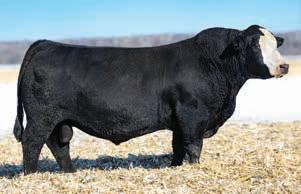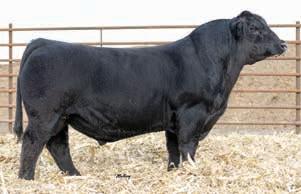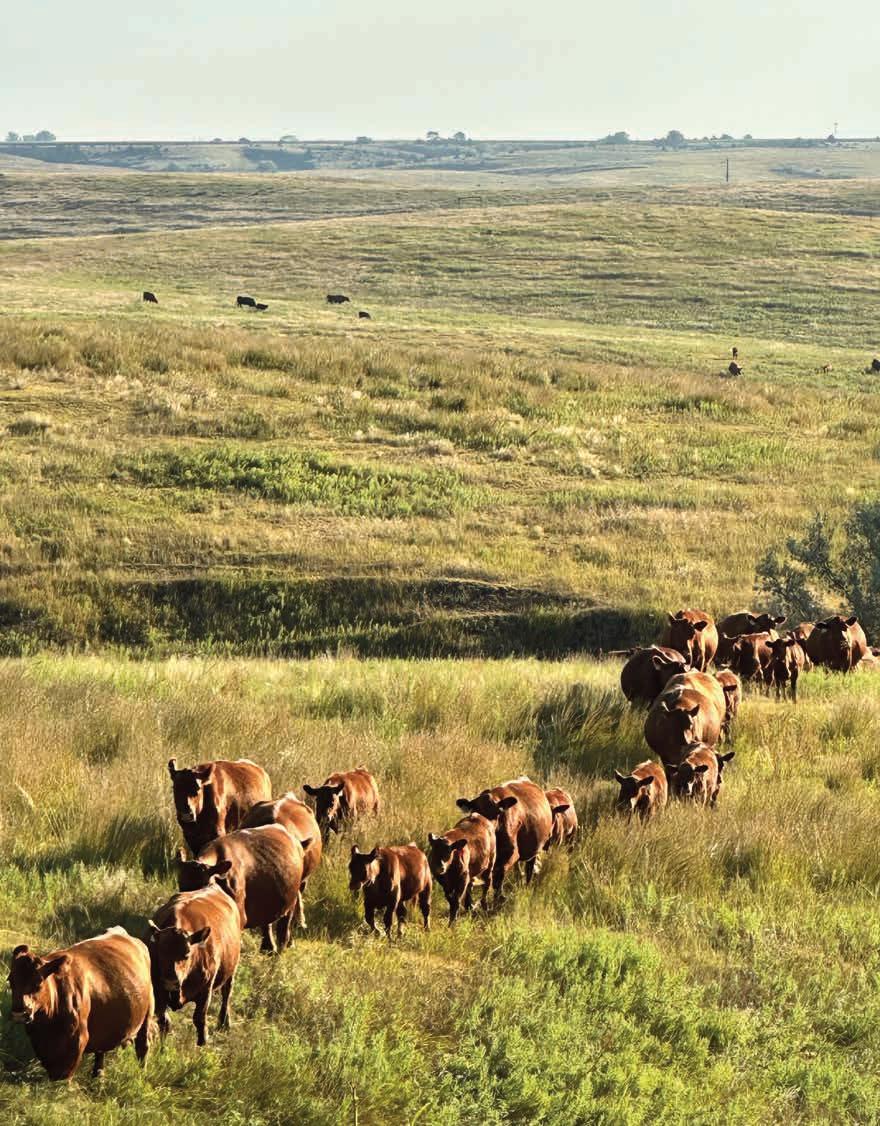
















Thanks for joining us! We are a free, premier livestock publication featuring and serving seedstock and commercial beef producers nationwide. Raising cattle is so much more than a hobby; it is our livelihood and our passion. We understand that, and in every issue want you to see not only incredible cattle, but also relatable, entertaining, and informative editorial features for the producer with 5 or 500 head.
To us, you are more than reader or advertiser; you are a beef producer. We are committed to doing our best for you, every day. Please feel free to communicate with us, your input is appreciated. The Stockman (ISSN 2694-1740), Vol. 6, No. 10,
BILL SCHERMER, Owner/Herd Consultant
641.425.2641 |

Bill and his wife, Nancy, have made their living in the cattle industry. He has provided marketing services for purebred and commercial breeders since 1970. Schermer Angus Cattle continues to be active in the NJAA and raises quality cattle near Clarion, IA. As owner of The Stockman, Bill leads by example providing producers with the highest level of customer service.
CHERYL KEPES, Assistant Editor
417.766.0990
cheryl@stockmanmag.com

Working for The Stockman is the perfect combination of two of Cheryl’s favorite things: writing and cattle. Cheryl has decades of experience as a professional writer. She finds great joy in sharing stories about people in the agricultural industry. Cheryl’s family raises registered Angus, Red Angus, and Simmental cattle in Fair Grove, MO.
KIM BANKS, Graphics
507.530.0914
kkbanks@frontiernet.net

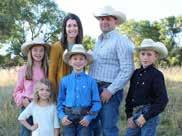
Makayla serves as editor, graphic designer, and manager of The Stockman. Her focus and passion continues to provide high quality service and original promotional materials to cattlemen. She and her husband, Jared, raise their four kids, and together they run their family operation, JMF Herefords and SimAngus, near Morris in west central MN.
SARAH HILL, Editorial Writer
307.274.0419
sarahhill1007@yahoo.com

Cheryl Kepes
Sarah Hill
Justin Fruechte
Dr. Vince Collison Kirk Lynch
Kim is a graphic designer with many years of design experience. Producing creative marketing materials to help others look their best is what she loves doing the most. She and her husband, Kevin, along with their son, raise grain and have a small commercial cow/calf and feeder operation on the family farm near Lynd, MN.

Sarah lives on a small hobby farm near Arlington, SD, with her husband, Braeton, and their three daughters: Harper, 8, Vayentha, 5, and Aurora, 1. She grew up on a Missouri dairy farm and has an Agricultural Journalism degree from the University of Missouri. Sarah enjoys baking, reading, and gardening.
MARIA OPHEIM, Social Media Manager
507-828-1374
riawbr@gmail.com

to Makayla Flower, 1530 10th St. NW Holloway, MN 56249.
Maria, her husband Cade, and daughter Tawnee, of Mound City, S.D. currently reside on their fifth generation commercial & Limousin cattle and grain operation. Maria also works as a R.N. She is excited to promote producers through The Stockman’s social media platforms!
TY BAYER
715.573.0153
tcreds@gmail.com

Ty works alongside his family in their purebred operations, Country Lane Farm and TC Reds near Ringle, WI. An advocate for youth programs and dedicated cow/calf man, he is excited to help producers merchandise their cattle.
JAN FORD
800.693.8048
jford17879@aol.com

With her passion for agriculture, Jan brings over 35+ years of advertising sales experience in the beef industry. She and her late husband Norm had a commercial Angus cow herd and grain operation near Tipton, IA, which her sons still manage today.
BARRETT SIMON
316.452.1792
barrett.simon8@gmail.com

Barrett comes with deep roots in both the Angus and Red Angus breeds with a growing base of customers marketing Continental based cattle as well. As an auctioneer, he represents many seedstock producers throughout the central plains. His direct ties to the commercial cattle industry are sure to be a benefit to customers of The Stockman.
CARTER WARD
carterward79@gmail.com
816.261.0891

Carter resides in Plattsburg, MO, with his girlfriend, Mandi, where they help run Ward Brothers Livestock with Carter’s family - their primary focus is Angus show cattle. Carter is also a partner in Campbell/Ward show cattle that specializes in the Hereford breed.
CHAD AND BRANDI CLAUSSEN
563.349.5089
chad.claussen@yahoo.com

Chad Claussen and his wife, Brandi, along with their two sons, operate purebred and commercial cow herds in Stockton, Iowa. The Claussen family also enjoys showing cattle, goats, and sheep. Off the farm, Chad works in the HVAC industry and Brandi works as an inventory and harvest coordinator.
RON HINRICHSEN
785.770.0222
rlangus@bluevalley.net

For the past 30 years, Ron, his wife, Lynne, and their two children have owned and
operated Hinrichsen Ranch, a registered Angus ranch in Westmoreland, KS. He has an extensive background in the agricultural industry and is excited to put it to work for each of his customers.
BRIGHAM AND MEGAN STEWART
785.747.8028
megancollisondvm@gmail.com

Brigham works alongside his parents at Mid Continent Farms, their large,
multi-breed cow/calf operation in Kansas. Megan graduated from ISU as a DVM in the spring of 2021 and is a big part of her family’s Angus herd and Veterinary Clinic in Iowa.
BRANDON CREAMER
970.596.4965
creamer b 150@hotmail.com

Brandon owns Lazy JB Angus with his parents and sister in Montrose, CO. Raised in the cattle industry, he has a true passion for it and loves marketing quality cattle throughout the US.
LORA HUTCHINS
615.293.3695
loralea1172@gmail.com

Lora owns and operates Destiny Angus Farm with husband Brian and daughter Morgan in Charleston, IL. They have raised and shown cattle successfully on the national level for several years. They also have owned a production herd with as many as 200 registered cows.
MARK SULLIVAN
816.304.0050
marksullivancattle@gmail.com

Mark Sullivan is a familiar face to many having worked for Sullivan Supply for many years. Mark brings many years of experience to The Stockman. Mark and his wife, Linda, and two children, Erin and Leo, live in Woodbine, Iowa, and have a small herd of Charolais cattle.

Steve is a third generation Hereford breeder - his family has been raising Herefords since 1951. He offers bulls by private treaty every year and has a heifer sale every fall. Steve also enjoys traveling to sales and shows whenever possible and likes camping as well. STEVE WOLFF 701.710.1574 swolff318@yahoo.com




Shipwheel
Destiny Angus Farm strives to run its purebred cattle


The Warner Ranch has built its Nebraska seedstock operation with strong, maternal Gelbvieh females at its foundation.
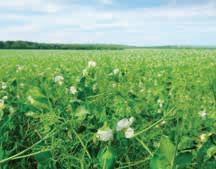

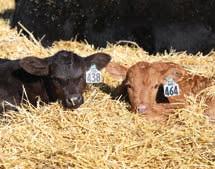


The most wonderful time of the year is upon us! The Christmas season is my favorite for so many reasons. I thoroughly enjoy all the typical traditions of decorating the tree with twinkling lights, baking too many cookies, and playing Christmas music on repeat. And while these are all fun and exciting things, I like to spend just as much time soaking in all the moments of hope, peace, and joy that radiate from our loving Father during this season. His amazing generosity is so evident, and it can be an inspiration for us all to follow suit by giving to others with a generous heart.
We are just a few short weeks from tapping into the beginning of bull sale season. Our design team would love the opportunity to help you with your promotional needs, including anything from catalogs and postcards to ads, logos, and pen cards! We can even be at your sale to provide ring service. Contact us at any time for a no-obligation quote. We look forward to promoting you!
From all of us at The Stockman to you, we wish you a joyful season with family and friends. Merry Christmas!
January 1, 2025
December 1
February 1, 2025 January 10
March 1, 2025 February 10
April 1, 2025
May 1, 2025
March 10
April 10
August 1, 2025 July 10
September 1, 2025
August 10
October 1, 2025 September 10
November 1, 2025
December 1, 2025
October 10
November 10








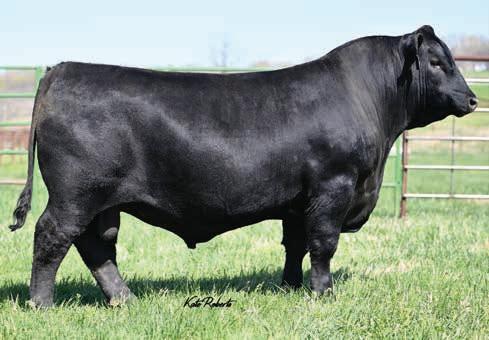






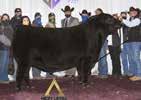




















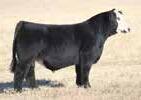

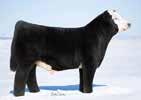





















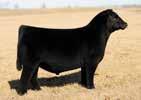














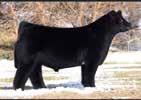

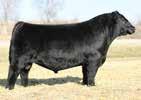








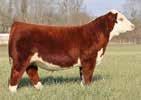

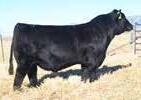





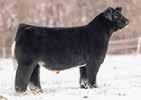

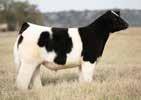
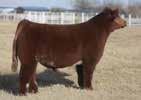












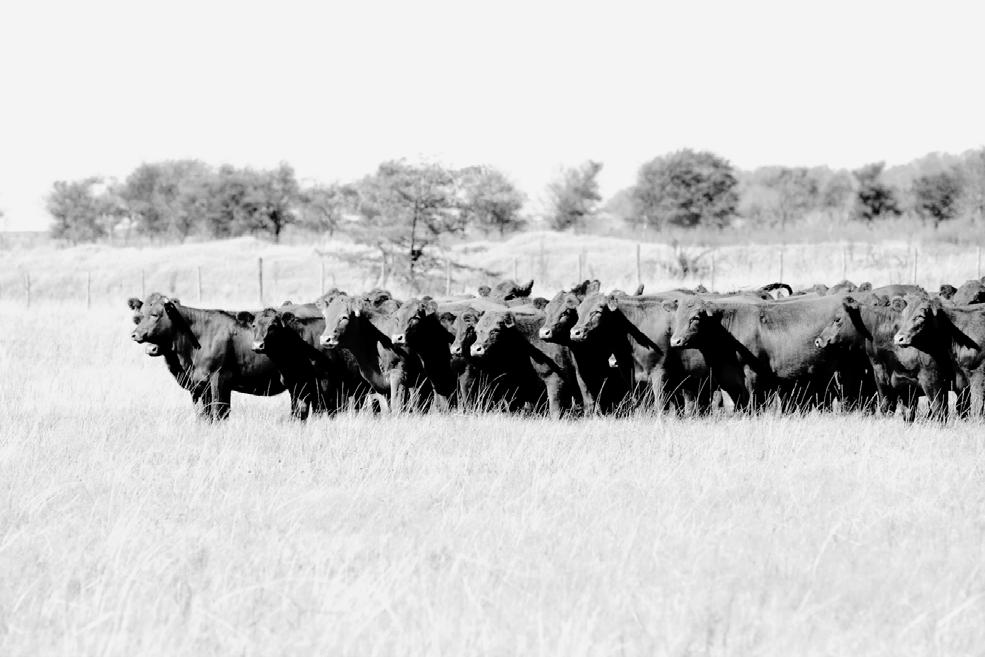







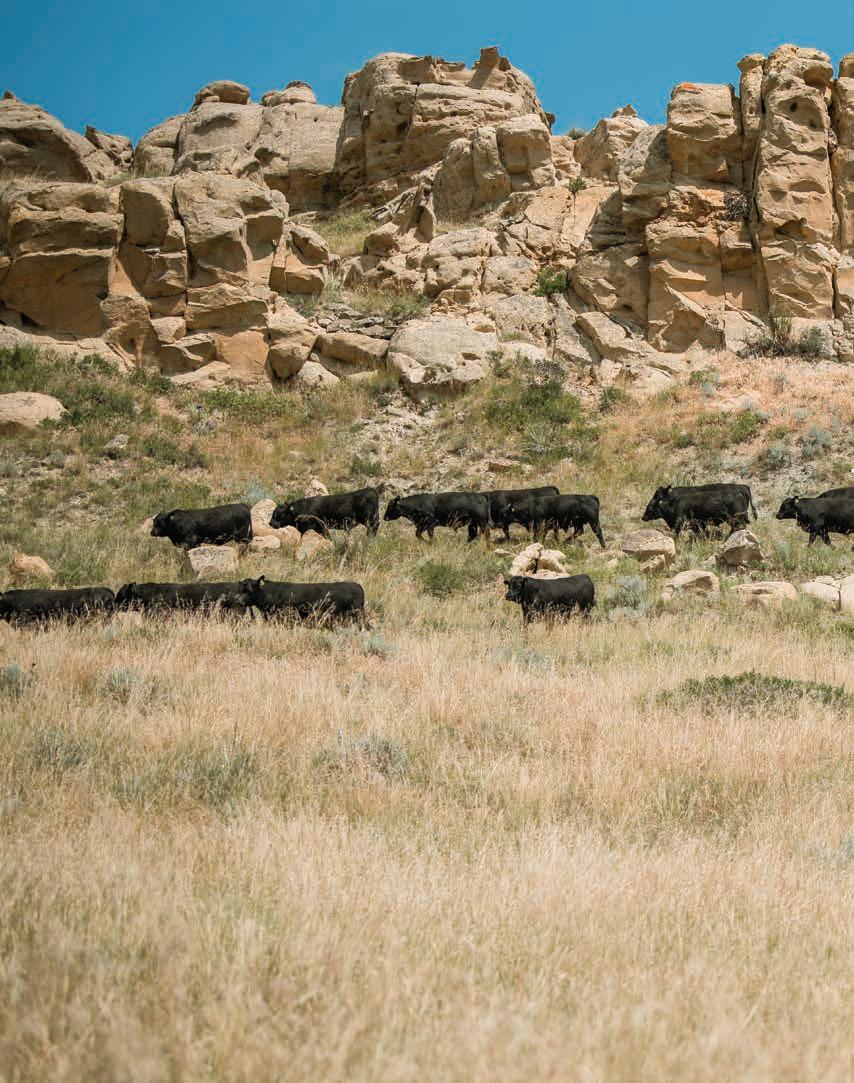
Shipwheel Cattle Company develops Angus cattle equipped for profitability and longevity.
The climate in North Central Montana is challenging at best. Rocky terrain, steep mountains, extreme temperatures, and sparse forage make this area seem less than ideal for ranching. But for the owners of Shipwheel Cattle Company, Klint and Lori Swanson and their children, Austin and Bree, the difficult environment actually enhances their operation.

The rigors of the region put Shipwheel Cattle Company’s genetics to the test, serving as a proving ground for their commercial and registered Angus herds. The Swansons develop Angus cattle with longevity, solid feet structure, and fertility. “There are not many second chances here with the cows. They have to prove themselves, if they don’t then they don’t last,” Lori Swanson explained.
The Swansons manage 400 head of registered Angus cows and 600 head of commercial cows on two ranches plus leased land. The Swansons flush around a half a dozen females each year. The donors are cows in their herd that have proved over time that they possess elite genetics. The Swansons utilize some of their commercial cows as recipients for the embryos. They put in approximately 100 embryos a year.

The operation’s headquarters, sale barn, and grow yard are located at the Clear Creek Ranch near Chinook, Montana. The family runs the registered cows primarily at the Snake Creek Ranch located in Lloyd, Montana in the Bear Paw Mountains.
The Swansons’ customers purchase Shipwheel Cattle Company’s genetics to infuse do-ability and profitability into their herds. The Swansons sell 150 breeding age bulls and 150 bred females each year. Additionally, they market hundreds of animals to sale barns.
Ranching in Montana appears to simply be a part of the Swansons’ being. “We are a family operation; we are proud of that. Between Lori’s family and my family, we have about 250 years of ranching in Montana - making a living off of a cow,” Klint Swanson shared.

Klint’s great-great-grandparents homesteaded on the Rocky Mountain Front in 1896. For decades, sheep and Hereford cattle reigned as the family’s livestock of choice. But Klint’s grandfather decided to forge a new path. In 1945, he brought Angus to the ranch to leverage a breed of cattle he believed was more fit to thrive in the environment. He was one of the first producers to intro -
duce the Angus breed to Northern Montana.
Klint’s parents, Daryle and Pam Swanson, founded Apex Angus in the 1960s. Continuing the lineage of developing Angus cattle operations, Klint and Lori formed Shipwheel Cattle Company in 2009. The foundation of their herd stemmed from two bred heifers given to Klint when he was 9 years old.
Shipwheel Cattle Company employs strict culling protocols and thoughtful genetic selections. The outcome of Klint and Lori’s disciplined management practices has paid off with a cattle herd known for its consistency, longevity, and profitability. “It’s been a lifetime; it’s been many generations in the process. We don’t chase fads. We don’t chase numbers. We just want good hardworking cattle,” Klint shared.
When making genetic decisions the Swansons aim for the middle. Their ideal cow weighs 1,350-pounds. Shipwheel Cattle Company avoids the extremes and focuses on females and bulls with a consistent genetic profile. The animals need to be good in all areas – EPDs, phenotype, and disposition. The Swansons’ cows are expected to range calve on their own so mothering ability, maternal instinct, and udder quality are very important.
“Our focus in on the momma cow – that is number one. She is what pays the bills here, she is the one that got us to where we are at today. We don’t breed cattle strictly for the feedlot or the show pen, we want a cow with longevity that will pay the bills,” Klint explained.

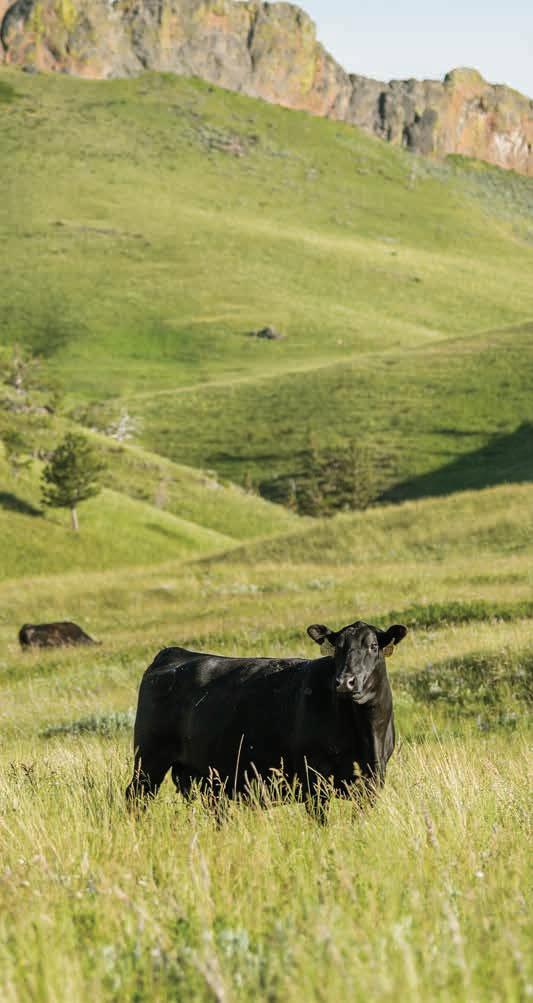

The cattle in Shipwheel Cattle Company’s program must be able to traverse rough terrain and significant distances in order to thrive.
Part of the Montana rangeland offers only short, scant native grasses. In these areas, it can take as much as 30 acres to sustain one cow.
Due to the environmental conditions, the Swansons require all their cattle to possess excellent hoof structure. There are no exceptions. “Our cows have to travel miles and miles in bad terrain, the cows with bad feet just can’t do that. So, we get rid of them,” Klint said. “We do not trim feet. I think hoof trimming
tables should be banned. That is the quickest way to clean things up.”
The Swansons are passionate about hoof health. They offer a three-year guarantee on their bulls’ feet. “We have to keep our customers in business. Most of our customers run cattle just like we do in terrain, Montana is mountainous and rocky,” Lori stated.
While foot structure is a critical selection criterion for the entire herd, bulls selected for the operation’s annual sale must also make it through an additional eight sorts.



The sale bulls are an elite group, representing the top 45 percent of the Swansons’ bull herd.
The first sort begins when the calf is in utero. “We start when the calves are inside their moms. We evaluate the mother every year before the calf is even born. If there is something wrong with her, she is down the road so that is the first sort. There are many after that. We are constantly evaluating them,” Klint said.
Calves are born out on the range in April and May of each year. After fence line weaning in the fall,

the bull calves are brought into the Swansons’ grow yard the first of December. The bulls are slowly developed on a roughage-based diet through the winter with a target of 2.5 pounds of gain per day. In May, the bulls are hauled to summer pasture where they range graze in difficult terrain.
The bulls are then brought back to the grow yard in October and prepared for the December sale. “Our bulls are never fat. If bulls get too fat it is not good for their longevity. We want bulls that are going to last 5, 6, or 7 years for our customers,” Klint stated.


Shipwheel Cattle Company’s ranches are located 60 miles south of Canada. The Swansons utilize 13,000 acres of owned land as well as 25,000 acres of leased land to develop their cattle.
It takes every acre to keep the herd thriving. “We can only graze these areas one time a year. We have to go on and graze the land, and then come off, then it has to rest until the next year. Our grasses and forages are very seasonal,” Lori explained.
Rainfall in the region is limited, sometimes as little as 10 inches a year. The ranchers rely on snow melt to irrigate the grasses in the spring and early summer. Once an area is grazed, it’s unlikely to regrow until the next season.

The weather fluctuations pose another challenge with frigid winters and sizzling summers. Despite the harsh climate, the Swansons are confident in their Angus cattle to hold up under the environmental pressures.
“We are breeding when it is 95 to 100 degrees, and they can withstand that down to 40 below in the wintertime. Sometimes they are calving in bad storms in freezing temperatures, and they can withstand that as well,” Lori said.
Klint also added, “Some winters are tough with the wind and the snow. We have seen 70 below wind chills, but like I say the Angus cow here, she gets through it. That is why we have them.”
The family takes a variety of steps to ease cattle through the winter months. Water supply lines to the waterers are buried six feet deep. Animals in the grow yard can seek shelter from the elements in wind shelters. The cattle on the ranges find shelter near trees.
Cattle receive complete rations processed through a mixer wagon in the winter months. A nutritionist works with the Swansons on the best total mixed ration to feed their
cattle. The ration includes hay and silage harvested by the Swansons on their land. They add distiller’s grain purchased from North Dakota to the ration to increase protein. The ration also includes pea and lentil byproducts from a local grain elevator.
The Swansons manage the entire operation with minimal outside assistance. They employ one full-time worker, occasionally part-time help and day riders. Most every task is in the hands of Klint, Lori, Austin, and Bree. All the feeding, calving, breeding, AIing, fence repairing, bookkeeping, trucking cattle (Austin takes the lead), catalog designing (Bree takes the lead) and anything and everything in between.
The family utilizes ranching strategies that been around for generations. “We take pride in keeping traditional values alive. Most all of our cattle work is done horseback,” Klint explained.
What might seem overwhelming to some feels natural to the Swansons. “That’s what we love about the ranching lifestyle – the variety of things that we can do every day,”
Klint said. “And there is no better way to raise kids.”
As the Swansons look to the future they plan to grow their registered herd. They are already working on expanding and are finding satisfaction in the opportunity to offer even more proven, high-quality genetics to their customers. “We definitely wouldn’t be where we are today without the help from the generations before us, everyone that has supported us, and God’s hand in it all,” Klint shared.

PRODUCTION SALE: Wednesday, December 11, 2024 1:00 pm MST - Chinook, Mont. learn more shipwheelcattle.com


SATURDAY, FEBRUARY 8
Judging Contest Auctioneer Contest
SUNDAY, FEBRUARY 9
Iowa Angus Sale
Iowa Limousin Sale
Iowa Simmental Sale
Iowa Charolais Sale
Iowa Maine Anjou Sale
Iowa Red Angus Sale
WEDNESDAY, FEBRUARY 12
Iowa Hereford Sale
THURSDAY, FEBRUARY 13
Junior Cattle Move-In
FRIDAY, FEBRUARY 14
Stockmen’s Market Traeshow
Junior Check-In
Sunglo No-Fit Showmanship
IJBBA Fitting Contest
IJBBA Year End Awards
Supreme Row Drive
SATURDAY, FEBRUARY 15
Expo Junior Show
SUNDAY, FEBRUARY 16
Expo Junior Show
DETAILED SCHEDULE
Iowa State Fairgrounds- Des Moines, IA
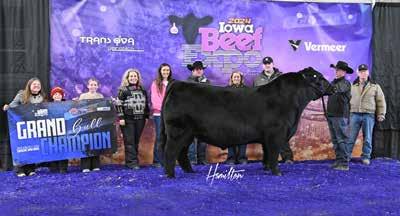




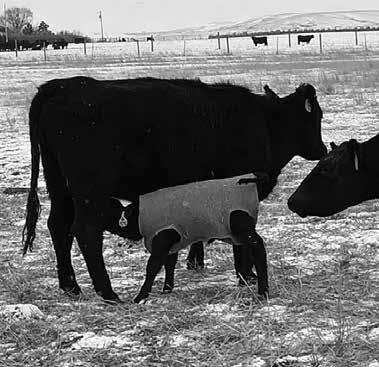
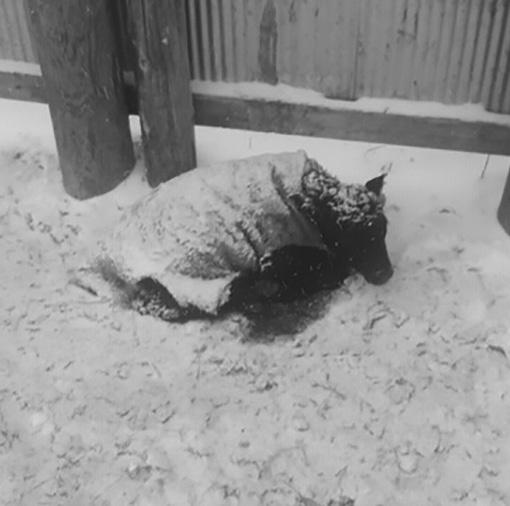

Fitting the FnF™ Beef Calf Cover to a new-born increased the actual hide temperature of the calf by 32 degrees Fahrenheit in just four minutes!
All beef ranchers are seeking to maximize their returns from their operation. A main income generator is the number of live calves that make weaning. The weather during late winter and spring can, and does, influence the number of newborn beef calves that survive some very brutal weather that can literally devastate the very survival of these new-borns.

Woolover® Ltd, based in New Zealand, is no stranger to devastating stock losses. In fact, Woolover® Ltd was “born of necessity” back in 1993 after two snowstorms, 10 days apart, claimed the lives of 2 million lambs and 40,000 calves. The answer is WOOL - Working 24/7
USDA figures suggest towards 80,000 new-born beef calves perish annually from hypothermia. Woolover® Ltd then set about designing and making a beef calf cover that was totally biodegradable, made from wool, is designed to fit an 85 lb new-born beef calf, and would simply “fall off” after 3- 4 weeks having ensured the new-born beef calf survived, was accepted by the mother, and captured some additional growth rates along the way.
The Result: The Woolover® Fit N Forget (FnF™) Beef Calf Cover.
• New-born calves fitted with the FnF™ Beef Calf Cover are simply not at risk of dying from hypothermia, and they will grow faster.
• The cover is totally biodegradable with wool providing the warmth and absorbency to wick moisture away from the hide and the Hessian Substrate providing some strength. Be it rain, snow, windchill or, simply from the birth process, covering a new-born beef calf with the FnF™ Beef Calf Cover makes sound financial sense. The cover will last for up to 3 – 4 weeks and then falls off.
• Designed for an 85 lb. live weight beef calf at birth, which is the optimum weight, but will also fit smaller calves.
• Wool is providing the warmth, is absorbent, breathable, comfortable to wear, is totally biodegradable and will ensure the Thermo – Neutral Zone, being the heart/ lung area, is kept at a constant temperature, both day and night despite the worst possible conditions = survival.
Dr. Clint Hilt, leading Veterinarian with MWI Animal Health, based in Power, Montana, who assisted with a trial of 50 FnF™ Beef Calf Covers on his clients’ newborn calves said, “THESE COVERS ARE LIVESAVERS.”
The trial was conducted on a day when it was -23 degrees Fahrenheit and, by simply fitting a FnF™ Beef Calf Cover to a new-born, the actual hide temperature of the calf increased by 32 degrees Fahrenheit in four minutes!
The Woolover® Limited FnF™ Beef Calf Covers: ORDER ONLINE at www.wooloverdirect.com or phone: Busse Barron Acres [ BBA ] 715 296 7596. FnF™ Beef Calf Covers are sold in units of 100 or packages of 10.
contact:
|

This Patent Pending design (pictured above) is the largest portable corral on wheels ever built. 22’ long panels, 6’ tall. 600-800 head capacity, all of which has a total weight under 15,000lbs. With multiple gates, spring latches, multiple pen capabilities for sorting.


Our most popular corral (pictured above with built in Loading Chute option), Hydraulic Adjustable Alley is now standard equipment. Head gate and size options available. Three sizes available; multiple pen options.
The Corral that started it all. Multiple pens, bumper or gooseneck models. Head gate option, 20’ long panels, 6’ tall. Sheeted temporary alley.
Bottom line: Strongest, largest and most portable corral ever built. Always made with animal and human safety in mind! Constantly making our product better and taking care of our customers is the goal.
#1 Warranty Available: As long as you own our corral, we will take care of you period. Call us to learn more.
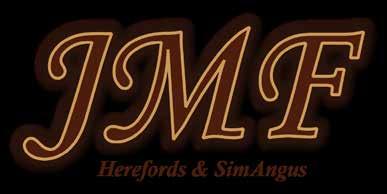


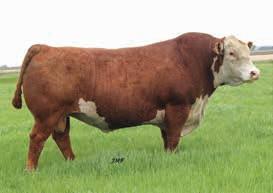





Karla Wilke, UNL Cow/Calf Systems and Stocker Management University of NE - Lincoln, UNL Beef beef.unl.edu
University research you can use.
any spring-born calves weaned in the fall are backgrounded through the winter prior to grazing summer grass or feedlot entry. There are many management options to consider for weaned calves depending on feed resources, labor, and subsequent management strategies.
Cornstalk residue can be a very economical forage resource in the northern Great Plains region. However, both cornstalk residue and dormant winter range can be very low in energy and protein making it necessary to provide some supplement to achieve targeted gains. A research experiment conducted in eastern Nebraska reported a loss of body weight in 500-pound calves receiving only mineral supplementation while grazing cornstalks. Calves supplemented 3.5 pounds of a mixture of corn, molasses, and urea only gained 0.5 pound per day while calves supplemented 3 pounds of dried distillers grains gained 1.3 pounds per day. This suggests the calves needed supplemental rumen undegradable
protein as well as energy while grazing cornstalk residue. Similarly, 450-pound calves in the Texas Panhandle grazing dormant native range gained 0.5 pound per day without energy or protein supplementation but gained 1.4 pounds per day when supplemented 2.5 pounds of dried distillers grains. In the Sandhills of Nebraska, 600-pound steers have been reported to gain 1 pound per day when supplemented 2 pounds of dried distillers grains while grazing winter range.
In integrated cropping and livestock regions, planting winter annuals such as oats, triticale, or rye after corn silage harvest can provide high quality winter grazing for weaned calves. Research in Nebraska has shown 550-pound calves to gain between 1.5 and 2 pounds per day when grazing oats or a mix of oats and radishes from November to January.
On the southern plains, wheat pasture grazing is a common practice during the winter. Research from Texas A&M evaluated supplement-
ing grazing steers (400 pounds) with 3 pounds of dry rolled corn or dried distillers grains. The calves supplemented with dry rolled corn gained similarly to the non-supplemented calves (2.86 pounds per day) while the calves supplemented dried distillers grains gained 3.08 pounds per day. It is important to note that after the feedlot phase, performance and carcass characteristics were not different across grazing treatments.
For producers with integrated livestock and farming operations and limited pasture acres, growing calves on a total mixed ration may be a viable option. Silages (corn and annual forage) and distillers grains are typically cheaper energy sources than hay. Another advantage of feeding a total mixed ration is that the nutrient density and intake can be controlled better than in a grazing situation and can result in not only the targeted gain, but also more uniformity in body weight of the calves at market. Additionally, research has shown calves placed

on a finishing ration shortly after weaning to be more profitable than those first placed on a growing ration. This is something to consider if the producer plans to retain ownership through finishing.
Supplementation strategies should always be evaluated based on the price of supplement including transportation and labor against the value of the gain derived from the supplementation on a yearly basis.
Research has shown cattle back-
grounded to gain 1.5 pounds per day maintain a weight advantage through the finishing phase over cattle backgrounded to gain less than 1 pound per day. Even though cattle restricted during backgrounding experience compensatory gain once they are placed on a higher plane of nutrition, they typically only compensate about 37-38%, meaning they continue to have lighter body weight than cattle backgrounded to gain 1.5 pounds per day.
Some producers retain calves through winter while others may
continue to graze summer grass with them, selling in the fall. Other producers may retain ownership through the finishing phase. Therefore, targeted gain and backgrounding resources should be evaluated against marketing strategies and the calf value. However, targeting adequate gain (1 to 1.5 pounds per day) to develop structural and muscle growth during the winter is advantageous regardless of marketing strategy.
Interviews with the authors of BeefWatch newsletter articles become available throughout the month of publication and are accessible at: www.go.unl.edu/podcast.

•Both are full brothers to R Plus Yuma 9087G who sold for $150,000
(1 solid black & 1 solid red)
She was the lead off female in the R Plus Dispersal sale in 2023.

R Plus Yuma 9087G


•Sired by CLRS Guardian 317G, KBHR Honor H060, R Plus Yuma 9087G, LBRS Genesis G89, Poss Deadwood & KBHR Gunsmoke J131
• Excellent fertility: She has averaged 23 frozen embryos in 18 IVF flushes.
A non-restricted use, emulsifiable concentrate formulation containing 40% permethrin*
Highly effective against flies, mites, ticks, lice and many other pests
Registered for use on beef and dairy cattle, goats, swine, poultry, sheep, horses and dogs
Can be mixed with oil or water for premise sprays
Powerful protection against horn flies, face flies, house flies, horse flies, deer flies, black flies and mosquitos
Can be mixed with oil for use in back rubbers


The perfect premise spray for use in barns, stables, farrowing houses, milking parlors and dog kennels
Easy to measure and once mixed, does not require further agitation
Works well in low-pressure pump sprayers as well as high-pressure power sprayers
Available in handy 4 fl. oz. bottles or economical quart jugs
Super concentrated: One 4 fl. oz bottle protects 393 cows from horn flies, lice and mange mites
Still the only 40% permethrin livestock pesticide on the market today
It all adds up to your best buy in livestock insecticides.
If you’re looking for one livestock pesticide that does the work of several, you found it with GardStar® 40% EC from Y-TEX. GardStar® 40% EC is the only 40% permethrin product registered for use on and around livestock. It delivers broad-spectum control of flies, mites, ticks and other pests on beef and dairy cattle, goats, swine, sheep, horses and dogs. And GardStar® 40% EC gives you the flexibility of applying it as a spray-on, dip, premise spray or in back rubbers. To learn more, see your livestock products supplier or visit www.Y-TEX.com






*GardStar® 40% EC is a restricted use pesticide in the State of New York. GardStar® and Y-TEX® are registered trademarks of Y-TEX Corporation. ©2024 Y-TEX Corporation.


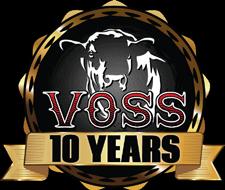




Westway’s liquid supplements support increased forage utilization, efficiency and convenience.
Sucrose sugars in Westway’s molasses-based products have been proven to increase fiber digestion. This means you get increased utilization out of your grass, hay, TMR or crop residue.
Liquid feeds provide better nutrition distribution across your herd. Available 24/7/365, our free choice liquid feeds support better body condition, getting more cows bred (and earlier) and less wasted feed.
To locate a dealer near you call: 800-800-7517 | www.westwayfeed.com

Destiny Angus Farm strives to run its purebred cattle operation and its new direct-to-customer beef sales business with steadfast integrity.
By

aking it to the top of the Angus industry requires unwavering dedication, vast expertise, and unrelenting passion. In an industry brimming with fierce competition, the pressure to succeed at any cost can be daunting. Yet, the owners of Destiny Angus Farm; Brian, Lora, and Morgan Hutchins, refuse to concede even the slightest shred of their high standards and values to prosper.
“When people purchase from us, whether it is show cattle or cattle that go to their breeding program or freezer beef, we do it the right way. We don’t cut corners,” Brian Hutchins explained.
Through the years, Destiny Angus Farm has achieved national accolades for its show ring success and powerful genetics. Last spring, the Hutchins family decided to diversify its operation, located in Charleston, Ill., to offer direct sale premium Angus beef. The addition of the beef business brings the operation full circle.



The Hutchins appreciate the opportunity to market premium Angus beef as well as produce national caliber show prospects, replacements, and herd sires. At the heart of the business lies a deeply rooted conviction to operate with the utmost integrity. The proper care of the animal reigns as their primary objective.
“Our cattle are all-natural showing, and they are all-natural when they hit the food supply. We take care of the animal first. We go out of our way to make sure the animal is happy and healthy. Whether it is for the show ring or even if they are terminal and end up being a meal someday, we believe in taking care of our animals,” Brian shared.

Though they cherish their successes, the Hutchins’ passion for agriculture keeps them dedicated to the industry. “We go out of our way because we just love animals. Even if they do enter the food supply at some point, we love taking care of our animals and doing it the best way we know how,” Brian stated.
The love for livestock started early for Brian. His dad, David Hutchins, owned an Angus herd for 40 years. When Brian was eight years old, he bought his first cow with money he earned working on the farm. He’s been entrenched in the Angus industry ever since.
Brian’s spent 45 years raising registered Angus and his passion for the cattle business is stronger than ever. The Hutchins family has worked for years to build its operation’s elite herd of Angus genetics. The family manages about 40 reg-

istered momma cows on their 60acre farm in Illinois.
Destiny Angus Farm has been selected twice in the past six years as a top 10 breeder. Brian and Lora’s daughter, Morgan, wrapped up her illustrious show career as one of the

gus genetics all over the country. In addition, Destiny Angus Farms has five bulls listed with Cattle Visions for semen sales.
The Hutchins recently embarked on a new endeavor. After evaluating ways to expand their operation, the family decided they had another product to offer in addition to production cattle and show animals. They decided to incorporate a direct sale beef business into their operation.
Brian explained the family’s rationale for starting the beef business, “The cattle that are good enough to show we show and the ones we want to keep back for the production herd we can, and instead of sending our beef level cattle to the stockyards we decided we will just harvest it ourselves and sell the beef as a premium Angus beef.”
The expansion emerged after Brian semi-retired from 30 years of holding executive leadership positions at farm retail companies. His lighter workload off the farm gave him margin to devote to the
new venture. Brian leaned on his wealth of experience as a business leader to vertically integrate the beef business into the farm operation.
The beef business took off from the start. The Hutchins were a bit surprised with its almost instant success. In hindsight, the Hutchins discovered one of the reasons for the quick success of Destiny Black Angus Beef was their extensive work and planning prior to beginning the business.
They partnered with three outside vendors to develop and finetune their website. The Hutchins attended presentations, conducted research, and queried direct beef sales business owners to help them successfully launch Destiny Black Angus Beef.
Though it turned out to be
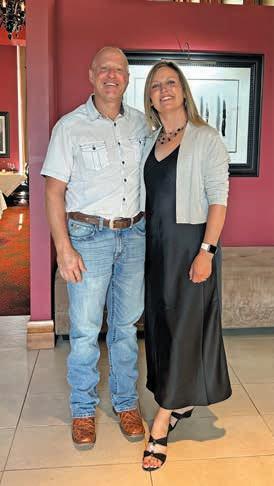


far more work initially than the Hutchins thought it would be, all their groundwork paid off. “We didn’t want to have too many false starts. We wanted to do it one time and do it right. So far it has worked out very well for us,” Brian said.
The Hutchins approached their beef business with the same passion and devotion to high standards as their registered Angus operation. The animals that are selected from their herd for their beef program are managed with similar care as the elite production and show animals.
All Destiny Angus Farm’s calves are pasture born and raised. The Hutchins do not spread pesticides or herbicides on their property. The fields are managed with rotational grazing and mowing, with occasional spot spraying as needed.
Cattle roam on pastures with plenty of forage, shade, and clean water. None of the animals are developed in pens or concrete feedyards. Even though the beef animals are grain finished to make sure they have optimal marbling, tenderness, and flavor, they have access to grass throughout their development.
Destiny Black Angus Beef processes several beef each month, a few more in the peak season. The business stands at 100 customers (some repeat) and counting. The Hutchins ship their frozen beef products anywhere within 250 miles of their hometown. Additionally, they are in the process of establishing central meeting locations for customers in nearby cities to pick up their orders.
When demand spikes, if the Hutchins don’t have enough of their own genetics to fill the beef orders, they reach out to their pre-established cooperative herds. These producers run their operations with Destiny Angus Farm’s genetics.


The producers also operate with the same philosophies and management style as the Hutchins.
Part of the Hutchins’ success may be attributed to their balanced approach to their operation. Their longstanding management practice of avoiding fads and breeding for good, consistent genetics positions them to reach their goals.
“We have always tried to maintain a very balanced approach whether it be show cattle, donors, sires, or EPDs and marbling. We have always tried to strike a balance and not go too far in a single direction,” Brian said. “What that does is, that allows us to accomplish all three facets of our business. Number one, good solid production cattle out in the pasture. Number two, successful show cattle. Number three, premium beef,” he added.
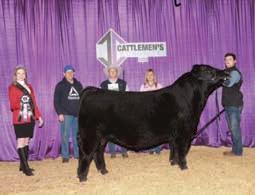
The expansion into the direct beef market is proving to be a positive choice for the Hutchins family. Consumers interest in food safety, awareness of inflation, and confidence with ordering food products online all equate to a rise in demand for the Hutchins’ products. “I think what people are finding out is they can buy a premium product for the same price or a little bit more than a subpar product at the grocery store or fast-food business,” Brian said.
The Hutchins look forward to what the future holds. As they grow this new aspect of their business, anchored in the confidence of quality Angus genetics, the Hutchins are excited to see where this venture leads.
learn more destinyblackangusbeef.com
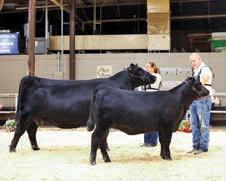

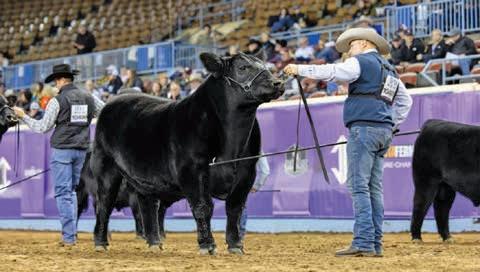


















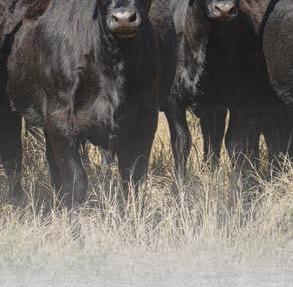






















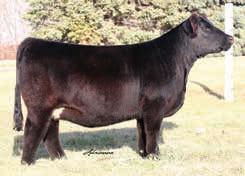

























































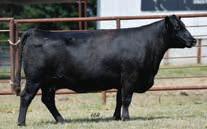



Functional forage and pasture.
contributed article by Justin Fruechte, Product Expert - Ag Renovo Seed, Brookings, S.D. renovoseed.com
inter feeding has started and if you’re anything like me, you’re constantly analyzing your forage supply as you pull away from the haystacks. At this same time, we start to brainstorm ideas for spring planting realizing that low quality forage supplies need to be recuperated. It seems that the high yields of this year’s grass and alfalfa harvests came with low quality for most folks in the Upper Midwest.
To talk about alternative forages with high protein content, I need to first mention the queen of forages with high protein: alfalfa. Alfalfa is, without a doubt, the most popular high protein forage used by producers across the country. It is adaptable, high yielding, and consistent. Most livestock producers should be using some level of alfalfa or alfalfa/grass in their operation for hay.
If you live in the high-country desert, Sainfoin may be a more suitable option than alfalfa. Sainfoin is a long-lived, drought tolerant, hardy perennial legume. In a two-cut system its yield rivals alfalfa, as does its protein content. Other ben-


efits include being bloat free and having resistance to alfalfa weevils and leaf hoppers. However, it tends to have more susceptibility to root pathogens and should not be used on low, wet soils. I’ve seen Sainfoin used best when seeded in a mixture of perennial cool-season forage grasses.
Forage peas will be another popular spring seeded forage this year. It is best to use forage peas in combination with a cereal grain. To optimize protein content, use a blend of 60 percent forage peas with 40 percent forage barley. Try to plant

this as soon as the field is fit this March or April, and you’ll allow yourself an opportunity to double crop with a warm season annual forage in June. Yield on pea/barley, pea/oat, or pea/triticale blends will be around three tons of dry matter per acre. This makes for a hefty windrow to cure correctly, so most growers have a backup plan to make baleage or haylage from these fields. Harvesting as wet feed will also help ensure higher protein and more palatable feed.
When June rolls around and you are searching for another high protein forage option, look to teff grass. Teff is an annual
warm-season grass that has proven to make hay with as high as 17 percent crude protein content. This small-seeded species needs to be seeded shallow into a firm seed bed, much like what you’d plant alfalfa in. Allow for 70 days before the first cutting, and with ample nitrogen and moisture you’ll have another cutting 25 days later. We’ve been extremely impressed with the quality of teff grass, and it can be used much like alfalfa hay in a diet without the risk of bloat.
The last high protein annual forage I want to mention is Italian ryegrass. This is a cool-season biannual grass with great persistence and quality. In the Upper Midwest, it should be seeded in the spring and harvested three to four times throughout the season. Expect a highly digestible feed with crude protein levels at 16 to 18 percent. Harvest it as wet feed, as it has a waxy leaf which inhibits proper dry down for hay.
Budget and plan out these op -
tions against your protein costs in rations. As fertilizer gets more expensive, these nitrogen-fixing legumes become even more appealing as high protein forage options. Take the time this winter to lock in your inputs for spring planting and you’ll be ready to roll when we thaw back out.
Photos courtesy Renovo Seed learn more renovoseed.com
Renovo Seed, Brookings, S.D.
The team of folks at Renovo Seed have roots that run deep in farming, agriculture, and in the overall respect for the landscape. They opened their doors in 1987 and continue to walk alongside farmers, ranchers, and landowners across thousands of acres throughout the Midwest.

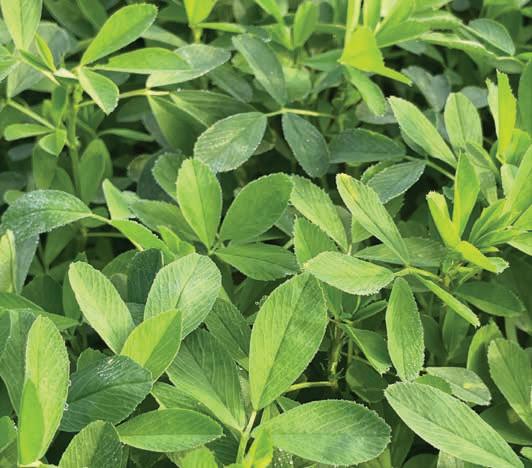
Saturday, January 11, 2025 12 Noon | Oklahoma City, OK
Selling High Quality Chianina & Chiangus Genetics
Heifers | Bulls | Bred Females | Genetic Opportunities

Chianina Cattle & Cocktails Sale Preview Friday, January 10, 2025 11 am • Cattlemen’s Bar


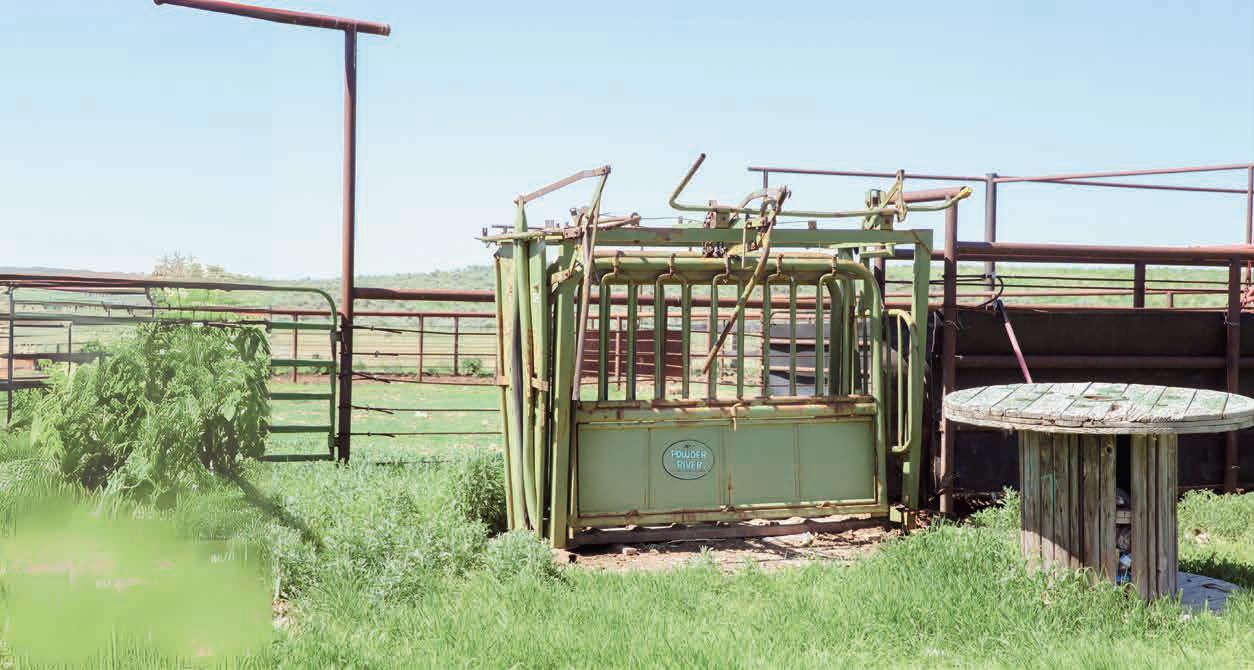

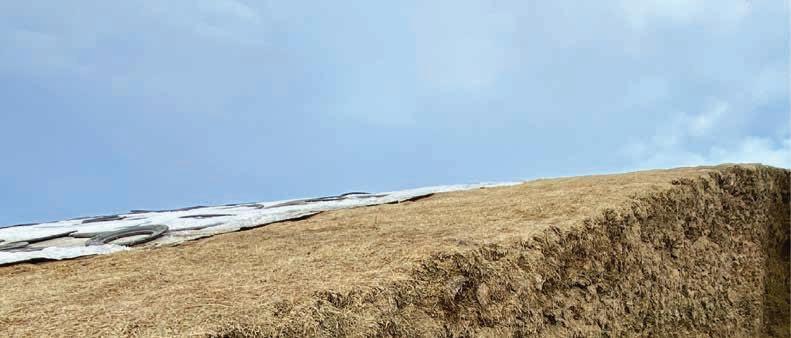





By Sarah Hill photos courtesy Warner family
The Warner Ranch has built its Nebraska seedstock operation with strong, maternal Gelbvieh females at its foundation.
A4-H or FFA project blossoming into a multiple generation commercial cow-calf and diversified crop operation is how Dan Warner describes his family’s ranch near Arapahoe, Neb. With 850 spring calving cows and 200 fall calving cows, there’s never a dull moment for the Warner family.
“What started as a hobby became a habit that got out of control, but we’ve been blessed to grow,” Dan said.
The family has a long history of being involved in the agriculture industry. Dan’s grandfather and uncles worked in production agriculture and his great-grandfather had cattle and raised crops. Prior to 1991, Dan’s parents, Monte and Kristie, had a commercial cow-calf operation influenced by Gelbvieh

sires. The Warners registered their first Gelbvieh/Balancer calves in 1991, when Dan was in high school. Dan decided his passion was the seedstock side of the cattle business, while his dad and brother, Darren, leaned more to the commercial side of the business.
After high school, Dan attended Northeast Junior College in Ster-
ling, Colo., where he competed on the livestock judging team. After two years, he went on to Colorado State University, where he once again represented the university in livestock judging. Dan returned home to the family ranch in December 1999.
The seedstock operation grew exponentially after that, primarily
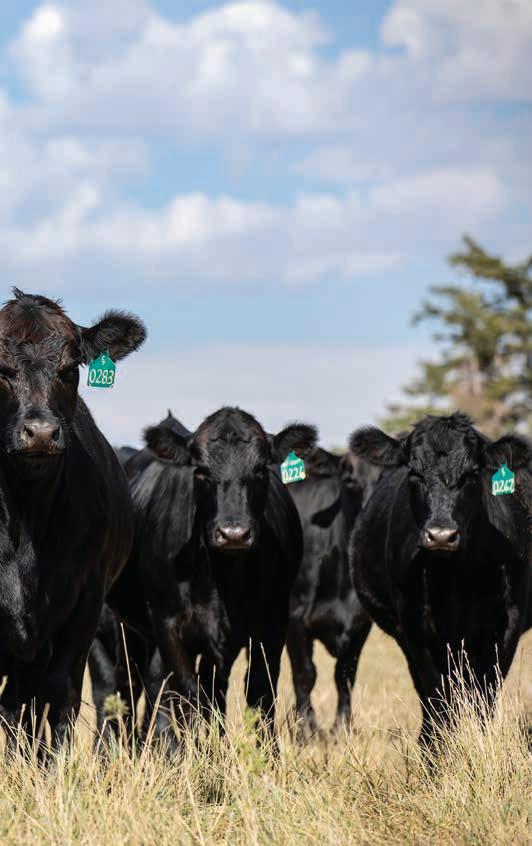
focusing on commercial cows, but ramping up using an embryo transfer program. At that time, the family was only selling bulls through private treaty, until 2005, when the family hosted their first production bull sale.
The operation includes 650 registered Gelbvieh, Balancer, and SimAngus cows, while commercial females are used as recips. The operation hosts an annual bull sale, selling about 150 bulls per year, and two annual female sales where they sell 100 to 150 registered and 150 to 200 commercial Balancer heifers.
The Warner family also sells cattle in an elite commercial bred heifer sale at the National Western Stock Show (NWSS) called the Maternal Merit Sale in the yards.
“We’re also part of a group called Maternal Merit that sells 300 to 500 commercial bred heifers from multiple breeds,” Dan said. “Maternal Merit sales sell first-generation baldies, red baldies, SimAngus, Angus, Red Angus and Balancer bred heifers, and all heifers are bred to ABS sires.”
Today, Dan has plenty of help with the operation. His parents are still involved, as is Darren, along with his wife, Amy. Dan’s wife, Kate, a real estate broker, also helps at the ranch, and the couple have four children: Gentry is a sophomore at Kansas State University; Berkley is a freshman at Creighton University; Kallan is in seventh grade; and Creyton is in third grade.
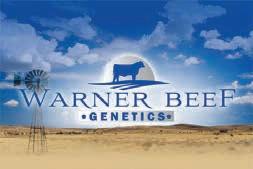


“Everybody would say they focus on a balance of traits in their cattle, but we focus on keeping cattle as maternal as we can,” Dan said. “We work with a very maternal breed, but we can also push very hard on performance and carcass quality.”
Dan operates by the philosophy that the cattle business is a people business, and cattle are just the by-product, because people buy bulls from people. He strives to run enough cattle to diversify their matings to meet different customers’ needs.
“Not everyone needs the same type of bull,” he said. “Some of our customers buy a Balancer bull as a terminal sire, so they want a bull that’s performance-oriented and carcass driven. Some guys want to build replacement females.”
The herd is handled with a commercial cow-calf approach, which Dan believes is important. Cattle are raised on crop residue, calve out in big pastures, and on-farm

labor isn’t focused on making sure every calf is born inside and gets up on its own—the calves must do it themselves.
“If cattle can’t survive in an environment that’s similar to that of their customers, then the genetics aren’t going to have any value,” he said. “In our embryo transfer program, we also make some matings
that are courageous attempts at creating outliers while staying true to phenotypic quality, structural integrity, and keeping cattle maternal.”
Dan said the biggest challenge for their customers is fertility, which he views as a baseline. He said he likes the Gelbvieh breed because they take the work out of ranching, and they fundamentally do things very well.
“This gives us the ability to focus on performance and carcass traits without having to worry about females getting or staying pregnant,” Dan said. “We stayed with the Gelbvieh breed because of their maternal emphasis. They’re basically 85 to 90 percent black and 100 percent polled. My goal is to make them look like an Angus with more performance and muscle.”
Spring calving heifers are bred at the end of April for a target delivery date around February 1. Mature females calve in February and March, while commercial cows calve out from mid-February to mid-April. The fall calving females are bred shortly after Thanksgiving to delivery between September 1 through mid-October.
“It feels like we’re calving all spring,” Dan laughed. “We own a lot of the bulls that we use for artificial insemination, which helps
create consistency and uniformity.”
One of the bulls raised by the Warners, DLW TPG Frontrunner 2510F, was the most widely used bull in their 2023 calf crop. Dan said that Frontrunner has been successful for them. For the 2024 calf crop, the main sires they have used are DLW TPG Glory 5141G and DLW Sand Trap ET - both bulls raised by the Warners.
“We use 10 to 12 different sires, including Angus bulls,” Dan said.
Mature cows graze on crop residue until calving. In the summer, the herd grazes native pasture and during calving is supplemented with a total mixed ration that includes dry hay, silage, and distiller’s grains. The Warners develop their own bulls and background feeder cattle in their feedyard. The operation produces all of its own forages and grains raised for feed,
only purchasing distiller’s grains and supplements.
The Warner’s children have all shown cattle through the junior breed associations, and Gentry currently serves as vice president of the American Gelbvieh Junior Association.
“I grew up through the junior associations, so it was a natural fit for my kids,” Dan said. “We take cattle to all of the junior shows, NWSS, and Cattlemen’s Congress. When we do show, we try to be competitive.”
Future plans are in motion at Warner Ranch, with Dan’s parents dispersing their cow herd this fall.
Dan said that production agriculture gets harder every day, but he remains optimistic.
“We’re trying to stay the course, be successful, stay relevant, be profitable, and grow where we can,” he said. “We hope the next generation wants to be involved.”
learn more warnerbeef.com

FEMALE SALE: Tuesday, December 3, 2024 1:00 pm CST - Arapahoe, Neb.








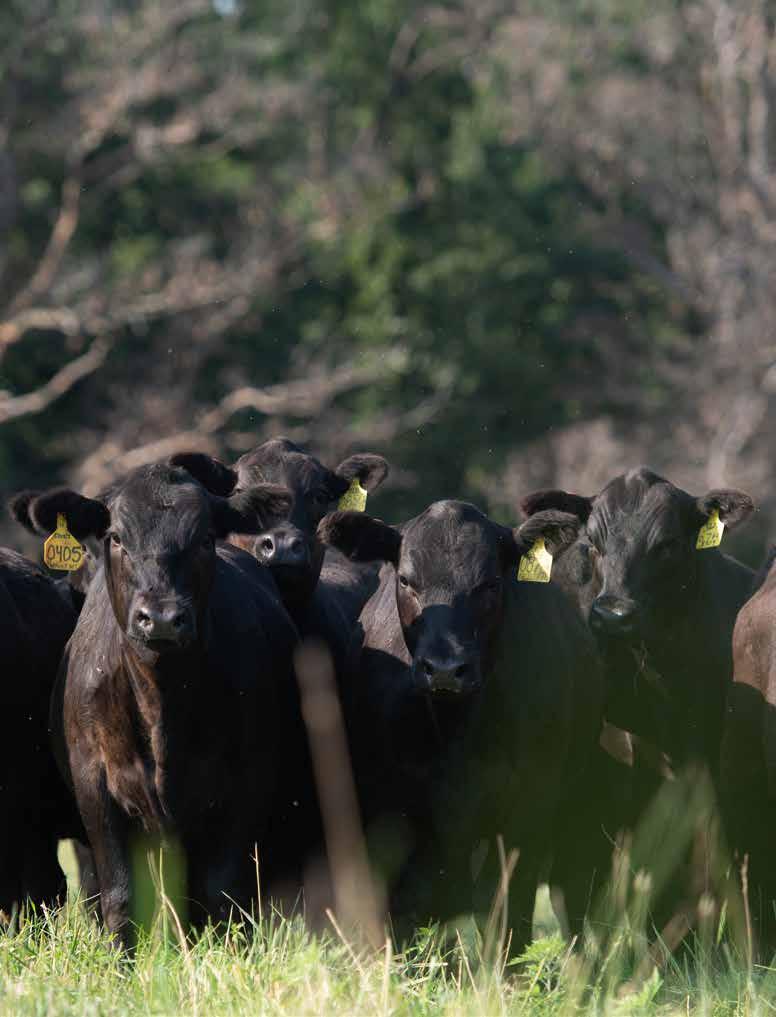
Additional Featured Sires:
Bobcat Blue Sky (*18880272)
GMAR Power Guard (19754679)
Carter Power Surge (19829429)
Connealy Craftsman (20132505)
Connealy Commerce (20132642)
Bobcat Exclusive (20206520)
Musgrave 316 Exclusive (18130471)


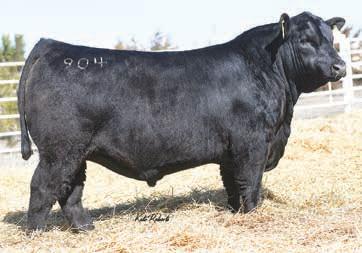




IHealth & Reproduction questions answered and explained.
contributed article by Dr. Vince Collison Collison Embryo and Veterinary Services, Rockwell City, Iowa collisonembryoservices.com
recently watched a webinar put on by Colostrx, which is a subsidiary of the Saskatoon Colostrum Company. As we approach a new calving season, there was a lot of information in this webinar which is relevant for the upcoming calving season. The main take away from this information is how important it is to intervene when a calf has any issues with nursing in the first few hours of life.
Typically, we think we have 24 hours to get colostrum into a newborn calf, but a graph displayed during the Colostrx webinar showed that in the first two hours is when the calf has the maximum absorption of colostrum (Figure 1). At this point, it is at about a 48 percent absorption rate.
From two to four hours after birth the absorption rate slightly drops off to about 45 percent. Starting at four to seven hours after birth, the rate of absorption falls off quickly to 20 percent. So, by seven hours post birth the absorption rate of colostrum is cut to less than half of what it is in the first four hours of life.
From seven hours to 22 hours the absorption rate gradu-
Colostrum needs to be fed quickly

ally declines from 20 percent to 10 percent. At 22 hours to 24 hours the ability to absorb colostrum drops off abruptly from 10 percent to 0 percent. This graph really emphasizes how small a window of time we have to make the biggest impact if we have a situation where we need to intervene.
The other point that was made is that colostrum absorption is reduced by about 35 percent whenever there is a dystocia (difficult birth). This makes it even more critical to intervene early whenever you have a calf that had to be pulled because of calving issues.
Whenever a calf does not absorb enough colostrum, it results in a condition called Failure of Passive Transfer (FPT). FPT is defined as having less than 10 grams/liter of IgG immunoglobulins in the blood stream. The rate of FPT within a herd is probably variable but has been reported to be as high as 31 percent. In the webinar, they presented a study conducted by the USDA Experiment Station in Clay Center, Neb. where they measured the effects of FPT in calves. What they found is that calves affected by FPT were:
1) 6.4 times the risk of sickness in the first 28 days of life
2) 3.2 times the risk of sickness prior to weaning
3) 5.4 times the risk of death prior to weaning
4) Had a 35-pound lower weaning weight
5) Calves grow at 2/3 of the growth rate of calves with adequate passive transfer
6) In the first 6 months, feed efficiency can be reduced by up to 50 percent
Another study presented that was done in Canada, showed similar results, but showed an even higher risk of death prior to weaning at 18.5 times more in FPT calves.
While FPT is defined as IgG levels of less than 10 grams/liter in the blood, to achieve excellent passive transfer the calf should have IgG levels of 25 grams/liter in the blood stream.
To prevent FPT we need to make sure calves are nursing well within the first two to three hours of life. If they are not nursing on their own, we need to intervene and ensure they are getting what the need by helping them nurse the cow or tube them with colostrum. Calves will need to take in 200 to 300 grams of IgG via colostrum to be sure that they achieve adequate passive transfer.
If you cannot get the calf to nurse the cow, it is probably better if you can get the calf to nurse a bottle of colostrum rather than tube them.
By nursing the bottle, the colostrum will go directly to the abomasum and give the most efficient use of the colostrum by the calf. When you tube a calf, much of the liquid will go to the rumen before it spills over to the abomasum. This will also work but may require more volume to get the same effect as nursing.
Another benefit of colostrum is its ability to help the calf with thermoregulation. The primary way that calves maintain their body temperature in cold weather is from brown fat. The brown fat is loaded with mitochondria that provide the energy needed to keep their body temperature high during cold weather. For brown fat to work properly, it needs to be activated from the fat in colostrum.
The thermoneutral zone for calves is 55 to 79 degrees Fahrenheit. So, it’s very important to have brown fat fully activated anytime the temperatures drop below 55 degrees Fahrenheit, which is pretty frequent during calving in the Midwest. Calves that take in enough fat via colostrum are more active, have higher performance, less death loss, and reduction of illness.
Besides the benefits from the antibodies and fats in colostrum, there are many other things that make colostrum important. There are many growth factors present in
colostrum, and it is a good source of vitamin A.
Also, colostrum aids in the growth of beneficial bacteria in the calf’s gastrointestinal tract. Proper colonization of the gut is important for normal digestion and acts as part of the calf’s defense mechanism against disease. All of these things play a role in the calf’s overall wellbeing for the first couple months of life.
I always feel that less is more when it comes to bovine health. I’m not implying that vaccines are not necessary to manage herd health, but in order to keep programs simple we need to take advantage of naturally occurring benefits like colostrum intake at birth.
Most beef cows will have good quality colostrum, provided they are getting what they need nutritionally and are properly vaccinated prior to calving. But if we do have to intervene, it’s nice to have options that increase convenience during times when we don’t have the time to catch a cow and milk her out or maybe don’t have the facilities available to restrain the cow properly to help the calf nurse or milk her out.
learn more collisonembryoservices.com
Dr. Vince Collison is co-owner of Collison Embryo and Veterinary Services PAC in Rockwell City, Iowa.
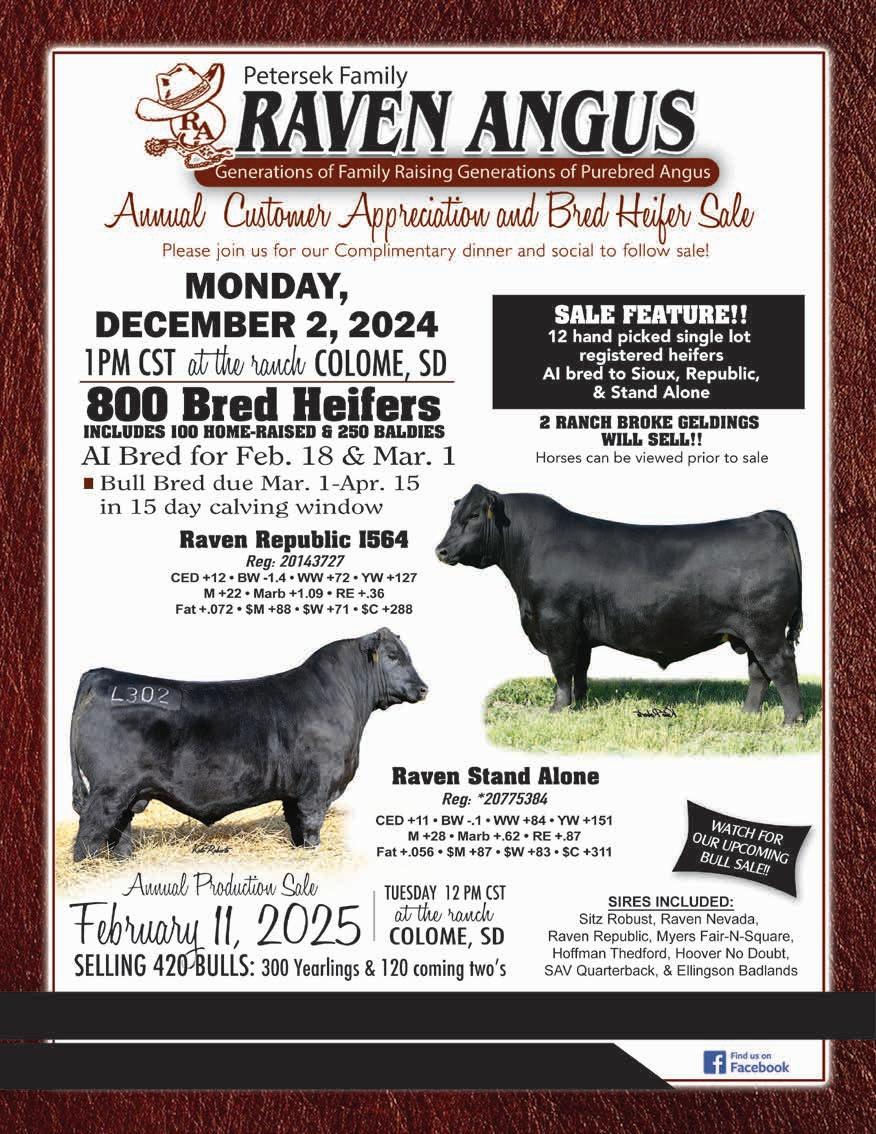




In the kitchen with

My family, which includes my husband, Gil, and our children, Corbin, Caroline, and Catherine, owns and operates Pleasant Hill Farms. The farm is a purebred Angus and Simmental seedstock operation located in south central Kentucky. Our operation’s roots trace back to Gil’s great-grandparents who purchased the original farm in 1920. We host two production sales every year, selling a large number of bulls to commercial cattle producers along with registered females to cattlemen all
We opened our meat farm store on June 15, 2024, and have been so overwhelmed with the support from our local community. It is obvious people truly enjoy supporting local businesses and we are ers beef from our cattle operation and pork which we buy from a local farm in our community. All our meat (both beef and pork) is processed at Hampton Meats which is a USDA inspected processing facility in Hopkinsville, Ky. We sell Legacy Dairy milk which is absolutely delicious. We carry a variety of wonderful cheeses from Maid-N-Meadows Farms. We also have photography from a local Bowling Green resident who captures the beauty of our country along with beautiful scenes of wildlife in their natural habitat. We carry locally made soy candles which are named after the prominent cow families in our operation and some that are named after things that mean a lot to our family (Farm Mornings and Blessings to name a few).
We sell Kentucky Mountain Coffee - something Gil and I have always enjoyed and yes, we drink it black. They have so many wonderful tasting coffees, but my favorite is Mountain Mornings. We have several to choose from and something for everyone.
The Butcher, The Baker, and The Coffeemaker Pleasant Hill Farms - Rockfield, Ky.
Cowboy approved recipes used by our favorite country cooks.
What is your most requested dish?
One of the recipes I have shared with you is “The Good Stu ff.” It’s a very good casserole that goes perfect with Frito Scoops. My entire family really likes this dish, so I make it often. It is very quick and easy
What is your favorite cooking tip/trick?
Never thaw meat in hot waterjust put it in a sink of cold water and it will thaw rather quickly.”
What is your least favorite job in the kitchen?
Of course, the clean-up!!!”
Mary Cowles
3 – 3 ½ pound roast
1 pkg. ranch dressing mix
1 pkg. au jus gravy mix

1 stick real butter pepperonis
Step 1: Take the roast and wash it in the sink. Place the roast in a Crockpot on high. Step 2: Sprinkle the package of ranch seasoning and the package of au jus gravy mix all over the roast. Step 3: Place about 4 to 5 pepperonis on top of the roast. Then place a stick of butter (real butter) on top of the roast. Step 4: Notice that there was not water or broth put in the Crockpot. After about 4 to 5 hours take the lid off the roast and you will be delighted at how tender the roast is. Take two forks and shred the roast apart. Enjoy with mashed potatoes or on some bread.
Our store is really not about me cooking but rather about the delicious farm raised beef and pork prod ucts we are able to o enjoy in the kitchen or on the grill. But I did learn to cook from my mom. She knew how to cook, and I am sure she learned from her mom.
One of the things I truly treasure is that a little while before my mom died, I asked her to write down the recipe (ingredients and directions) for her cornbread dressing she made every year at Thanksgiving and Christmas. It was the best dressing I have ever eaten. (Gil used to brag on Mom and tell her how delicious her cornbread dressing was. She loved him, and his compli ments about her cooking always made her smile). Mom gave me a puzzled look and said, “I don’t use a recipe!” But she tried to think through it, and she did manage to write it down and walk me through how it all works. Our mom passed away a few years after that. My siblings and I, along with our families, got together for Thanksgiving and we tried to rep licate what our mom made so many years of her life. It turned out fine but like Gil told us all that day, “It is not as good as what Nana made!” I hope I can make meals that taste as good as my mom did.

1 lb. ground beef
1 lb. sweet Italian sausage ½ box lasagna noodles large container ricotta
Mary Cowles
2 eggs fresh mozzarella log, sliced pepperonis
Step 1: Brown ground beef and Italian sausage. Drain any excess grease off the meat and set aside. Step 2: Cook lasagna noodles (usu- ally half a box of noodles is plenty for a 9x13-inch casserole dish).
Step 3: In a large mixing bowl, combine a large container of ricotta cheese and 2 eggs. Step 4: Spray casserole dish with cooking spray (I really like avocado oil spray). This is where you start to layer your lasagna. Step 5: Start with a cup or two of the meat sauce on the bottom of the sprayed pan. Then layer with cooked lasagna noodles (I leave mine long). Then layer with the ricotta cheese and egg mixture. Then add the pepperonis. I use Boar’s Head - I think they are extra tasty. Step 6: Layer with sliced real mozzarella cheese. I like to use the logs of mozzarella cheese, and simply slice it into thick slices and then layer it all over the pepperonis. Then you repeat the layering process. Step 7: Finish the layering process with a bit of the meat mixture on the top with mozzarella cheese over that. Bake at 350 degrees Fahrenheit for approximately 50 to 60 minutes.
Note: The cheese on top will brown and the meat sauce should be bubbling hot. I usually serve this with garlic bread and a nice salad with a delicious ranch dressing.

Mary
Cowles
1 lb. ground beef
1 lb. chorizo sausage
1 jar picante sauce
1 can whole kernel corn

1 pkg. taco seasoning shredded taco blended cheese Frito Scoops
Step 1: Brown the ground beef and chorizo sausage. Drain any excess grease off and layer the browned meat in a 9x13-inch casserole dish that has been sprayed with cooking spray. Step 2: Pour in jar of pican- te sauce, can of whole kernel corn, and the package of taco seasoning. Step 3: Mix all of this together and layer on top with shredded taco blended cheese. Step 4: Bake at 350 degrees Fahrenheit for 30 min- utes. Serve with Frito Scoops and enjoy!!

30th ANNUAL BULL SALE: Saturday, February 22, 2025
At the PHF sale facility near Rockfield, Ky.
5th ANNUAL KOUPAL ANGUS INFLUENCE BRED FEMALE SALE
Offering over 700 reputation commercial bred heifers & young cows!
December 6, 2024 11:00 am
Stockmen’s Livestock in Yankton, SD
Broadcasting on cattleusa.com
For more info, contact Dan at 605-491-1331















Is I wrote this article, we have received our first snowstorm of the winter and my four little ones could not wait to throw on their snow pants and go play in the white stuff! Me on the other hand, not so excited about leaving the warmth and comfort of my office. It is because they are looking forward to joy and fun and I am dreading frozen waters and/or sick cattle. Either way, it is safe to say that winter is upon us!
A review of the current cattle market.
this fat cattle deal to continue an upward trend going into the new year and into spring. How high we can go, that is the million-dollar question!
contributed article by Kirk Lynch Lynch Livestock Inc. and Humeston Livestock Exchange, Humeston, Iowa humestonlivestockexchange.com
Now to look at some of the market reports that we have been seeing in the barns. The fat cattle market has been on a hot streak for several weeks, until this past week, when we experienced a slight dip in the market. We have seen some highs in the mid to high forties, but these have been some extremes. Most cash cattle in the country have been trading at forty level or slightly higher the past couple of weeks. I expect there to be a few bumps in the road, but I expect
t is hard to believe that we are al ready at the end of 2024 and to this point it has been a relatively un eventful year in the cattle markets compared to the past several years. We always seemed to have some event that caused a big dip in the market and took us several months to recover. I guess if that happens here in December you can blame me for jinxing it.
The feeder market has been very solid throughout the fall with a lot of yearling cattle bringing in the mid $2’s. We’ve been seeing several front-end steer calves pushing and a few exceptions of them surpass ing the $3 mark. Most are bringing in the high $2 range, most heifers coming in from $10 to $20 back of the steers in both the yearling and calf categories.
The higher fat cattle market is driving a higher price for the feeder cattle market as well, even with the higher feedstuff inputs. We have seen some front end big strings of 800 pounds bringing well into the sixties and some 600-pound cattle bringing into the seventies and eighties. Once again these are some extreme tops. We have been trying to fill up our own lots as fast as possible, as I am not sure the feeder cattle are going to get any cheaper. We have been able to find cattle at cheaper prices than that and so when we do projects they are in the black.
The cull cow and bull market has lagged the fat market, as from all reports there have been around six
Kirk Lynch, Lynch Livestock Inc., Waucoma, IA Kirk is the Beef Division manager for Lynch Livestock Inc. and oversees all aspects of their backgrounding and cattle feeding operations throughout Iowa and Kansas. He is also deeply involved in the newly reopened Humeston Livestock Exchange in Humeston, Iowa. In addition, Kirk and his wife Mary own and operate Heartland Simmentals in Northeast Iowa, which is a seed stock operation that consists of 500 registered Simmental and Angus cows. They have four children: Gabrielle (8), Brayden (7), Vivian (5), and Bianca (1).
The fat cattle market has been steady. It is going to be the common theme with cheap feed that we are going to make these cattle heavi er at slaughter which will make it very difficult for this market to get above the $1.80 to $1.90 range that we have been in for a while now. I would look for this to continue for the first part of 2025 and if we continue to make more and more

Humeston, Iowa 641-877-6092


percent more last year, making supply of cows. down, which be into next year, cow and bull with the same market.
The breeding been up and cently, I heard commercial pairs $2,000 and then can buy all the I want for $1,200 are looking to now is the time reasonably priced with increased are going to be ply over the next Wishing everyone Christmas and

Well, I hope everyone had a great Thanksgiving and wishing everyone a Merry Christmas. Next time I talk to you it will be 2025!

Annual “Black Friday” Production Sale every November. Follow us on Instagram & Facebook for daily updates on our program. Visit our website:
Josh Scheckel | 21582 Hwy 62, Bellevue, Iowa call: 563.872.4112 | email: josh@jjscheckel.com www.AngusCattleGenetics.com


-





FOR IMMEDIATE RELEASE
WISCONSIN CATTLEMAN AWARDED YOUNG BREEDER OF THE YEAR BY THE AMERICAN ANGUS ASSOCIATION®
The American Angus Association® awarded its second annual Young Breeder of the Year award to fourth-generation Angus breeder Cody Quam of Lodi, Wisconsin on November 3, during the 2024 Angus Convention held in Fort Worth, Texas.
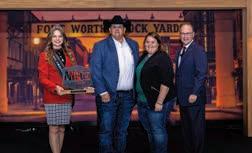
Known as a humble, quite man, Quam is not afraid to generously share his knowledge of the cattle industry. “I’ve made it a point to try and help anybody that will take the time and ask, and are willing to put the work in,” said Quam when asked to reflect on why he was selected for the award. “I’ll share what we’ve done right and what we’ve done wrong to try and help people that are just getting started to maybe get there a little faster.”
It’s a wealth of experience Quam and his family have spent more than eighty years gathering while building the reputation of Marda Angus Farm. Quam’s great-grandfather purchased the family’s first Angus heifers as 4-H projects for his son in 1942. That same year, he also purchased two Hereford heifers for his daughter. The Angus cattle stayed, the Herefords didn’t, so the family story is told by Quam; “It’s hard to deny the quality of the Angus cow.”
Twelve years ago, Quam was able to come back to the farm full-time, bringing with him ideas gathered not only from his time working in sale barns and feed mills, but from his time volunteering. As part of two terms served on the Wisconsin Angus Association’s board, Quam helped run the state’s futurity sale.
“That was the most interesting because you could help a wide diversity of Angus breeders across the state,” recalled Quam. “It is also probably the most educational thing I’ve done, that’s benefitted this farm.”
Quam now leads Marda’s genetic selection and donor/ET program as well as sales and marketing. Under his stewardship, the operation has earned multiple top honors at the Midland Bull Test and hosted its 9th production female sale on November 16.
“What I truly believe about this breed is you can find your home in it – no matter what you want to raise, what you want to sell, what you want to have as your cow herd,” Quam reflected. “Do what you like, and if you’re persistent enough, you will find a place.”
For Quam, that place is on the family farm where he works sideby-side with his 92-year-old grandmother, father and mother, and gets the joy of raising his two children with his wife on the ground that instilled in him a love of Angus cattle, a pension for hard work and the desire to give back.
The Young Breeder of the Year Award recognizes a young, registered Angus breeder for their leadership within the Angus breed, participation in Angus programs and innovation within their herd.
-Written
by Jessica Hartman, Communications Specialist
Connealy Craftsman records over 4,000 progenies.
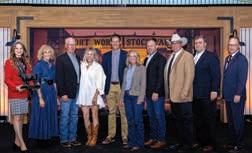
For over 150 years, the popularity of Angus cattle has grown, making over 80 percent of America’s cow herd influenced by Angus genetics. Influential sires have made their mark and during the 2024 American Angus Association® Awards Dinner and Reception on November 3rd, 2024 in Fort Worth, Texas, the Association recognized the sire registering the most progeny.
Connealy Craftsman owned by Select Sires Inc., Plain City, Ohio, and Sexing Technologies, Navasota, Texas, sired 4,014 calves registered into the Angus herd book, the most in fiscal year 2024.
“We were interested in this bull for a variety of reasons, but it was phenotype that set him apart for us. His $M index and foot scores were excellent, and his pedigree was something different for us,” Brian House of Select Sires Inc. said.
“When our team set their eyes on him, they very quickly selected him as the ‘special bull,’ in that sale.”
Recognizing these sires highlights the breeders dedicated to providing top-quality Angus bulls.
“Our members enjoy wide diversity in genetics to achieve whatever their breeding goals are,” said Mark McCully, chief executive officer of


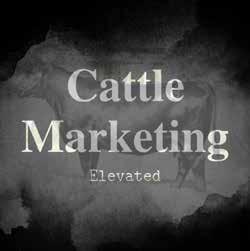














(continued...)
the Association. “We’re thankful for these cattlemen committed to breed improvement.”
The top 10 sires are recorded from October 1 through September 30.
2. GB Fireball 672, ABS Global Inc., De Forest, Wis.; Goode Angus, Pampa, Texas; and Grand Bayou Farms, Ruston, La., 3.500 calves
3. Deer Valley Growth Fund, Deer Valley Farm, Fayetteville, Tenn., 3,368 calves
4. Sitz Resilient 10208, Bar J V Angus Ranch, Fairview, Mont.; Dan Ingalls, Casper, Wyo.; and Lunds B Bar Angus, Wibaux, Mont., 3,332 calves
5. Tehama Tahoe B767, Midwest Genetics, Long Island, Kan.; Tehama Angus Ranch, Gerber, Calif.; and VanDerVeen Farms, Phillipsburg, Kan., 2,411 calves
6. LAR Man in Black, ABS Global, De Forest, Wis., and Larson Angus Ranch, Sharon Springs, Kan., 2,292 calves
7. DB Iconic G95, Douglas Booth Family, Torrington, Wyo., and Genex Cooperative, Shawano Wis., 2,273 calves
8. Sitz Stellar 726D, ABS Global, Inc., De Forest, Wis., and Sitz Angus Farm, Dillon, Mont., 2,165 calves
9. Poss Rawhide, Danny Poss, Scotia, Neb., and Sexing Technologies, Navasota, Texas, 2,090 calves
10. GAR Home Town, Gardiner Angus Ranch Inc., Ashland, Kan., 2,068 calves
-Written by Amber Wahlgren, Communications Assistant
Proprietary technology assists with breeding success in herds that use artificial insemination and embryo transfer, plus alerts caregivers to cows needing attention
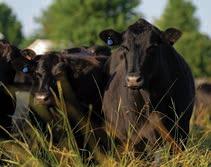
RAHWAY, N.J., – Merck Animal Health has announced the introduction of SENSEHUB® Cow Calf, remote monitoring technology designed to help optimize breeding results with less labor for cow/calf producers, including seedstock and club calf producers, who use artificial insemination (AI) or embryo transfer (ET)
SENSEHUB Cow Calf monitors behaviors that help to detect estrus, determine ideal insemination windows, and uncover potential reproductive issues faster than human observation alone. The technology continuously analyzes data being collected and delivers convenient alerts to smartphones, tablets, or desktop computers, saving producers time typically required for visually observing heats.
“For producers using AI or ET, SENSEHUB Cow Calf takes the guesswork out of identifying the breeding window,” said Lauren Wottlin, research and development field trials manager, Merck Animal Health. “Reproductive efficiency is critical, especially in high-value
animals. Automated heat detection helps to determine when an individual cow or heifer is in estrus, so you can inseminate her at the best time to optimize conception rates and minimize calving intervals.”
The technology, which features a new algorithm, also improves the ability to address reproductive issues. It helps to identify a heifer or cow that does not conceive earlier than ultrasound or traditional pregnancy checks. Animals not having regular cycles are identified, and a report can be generated for animals suspected of aborting.
An additional benefit to the technology is the ability to continuously keep an eye on herd and individual animal well-being.
“By tracking activity and rumination with an ear-mounted accelerometer in real-time, the system can alert you early when a cow or heifer needs attention,” Wottlin said. “Early detection and intervention can improve treatment outcomes, plus give you peace of mind knowing your animals are being monitored.”
SENSEHUB Cow Calf integrates with several cattle management platforms and will be available directly via online ordering through the Merck Animal Health website.
Minimal hardware is needed, and the system is easy to install. Data recorded and analyzed by SENSEHUB Cow Calf is used to create simple-to-read, understandable dashboards. It is backed up and stored in a secure, cloud-based system. SENSEHUB Cow Calf ear tags also illuminate and flash, making it easier for caregivers to find animals flagged by the system.
SENSEHUB Cow Calf is part of the SENSEHUB family of brands from Merck Animal Health, pro -
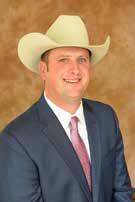

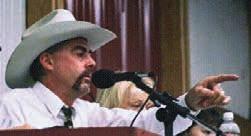









viding advanced monitoring technology to give actionable insights to cow/calf, stocker, feedlot and dairy producers for optimal herd productivity and management.
“Merck Animal Health is committed to advancing the health, productivity and well-being of cattle and contributing to the ongoing success of our customers’ operations,” said Kevin Mobley, exec-
utive director of cattle sales and marketing at Merck Animal Health. “SENSEHUB Cow Calf is another example of using monitoring innovation to bring insights-driven solutions to our customers.”
For more information about SENSEHUB Cow Calf, visit SenseHub-CowCalf.com.
SENSEHUB technologies are not
intended to diagnose, treat, cure, or prevent any disease in animals. For the diagnosis, treatment, cure, or prevention of diseases in animals, you should consult your veterinarian. The accuracy of the data collected and presented through this product is not intended to match that of medical devices or scientific measurement devices.




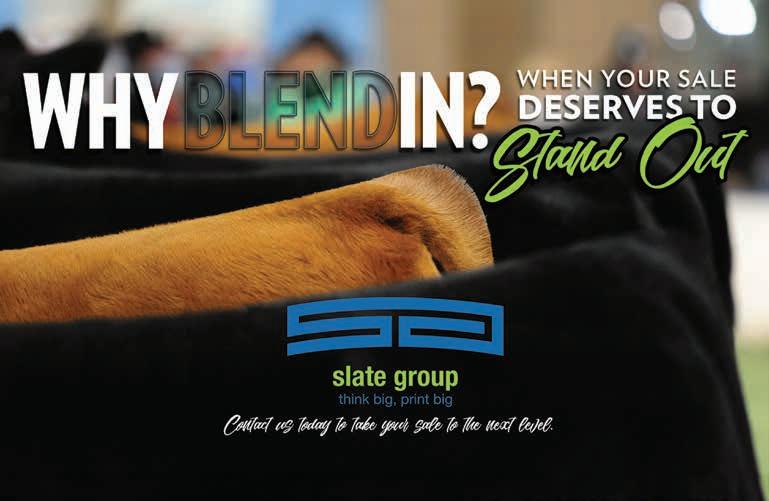
American Chianina Assn.
Backroad Creative
Blue Lake Plastics
Bobcat Angus
BritAmerica Mgmt. Group
Cattle Visions
CJ Brown Studios
Collison Angus
Conover, Al
Conover, Jeanne
Crawford, Scott
Cross Diamond Cattle Co.
CSL Auctions Inc.
Ellingson Simmentals
Friedrich, Parker
Gilchrist, Kyle
Gold Buckle Cattle Services
Graham Angus
Gutwein Angus
Humeston Livestock Exch.
Integrity Stock Shots
Iowa Beef Expo
J.J. Scheckel Angus
Jallo Angus
JMF Herefords & SimAngus
Koupal’s B&B Angus
Layton, Dustin
Linz Heritage Angus
Lowderman, Monte
Lowderman Auction Options
Matthews Coach’s Corral
McFarland Productions
Money Maker bull
Muir Embroidery
Petersek’s Raven Angus
Pleasant Hill Farms
Powder River
Rawhide Portable Corral
Renovo Seed
Royal Classic Sale
Safety Zone Calf Catchers
Schooley Cattle Co.
Sealpro Silage Barrier Films
Shipwheel Cattle Co.
Slate Group
The Judge Source
Voss Angus
Wall Street Cattle Co.
Warner Beef Genetics
Weishaar, Seth
Westway Feed Products
Wheeler Angus
Woolover, LTD
Y-Tex Corporation
ZWT Ranch


About the Stockman.

I have been raising cattle my whole life. I grew up milking Holsteins and with a registered Shorthorn herd. We sold our Shorthorn herd to my uncle when he bought a ranch in Montana. In 1978, I graduated from North Dakota State University with a bachelor’s degree in animal science. My wife, Dee Ann, and I were married in 1988. In 1990, we sold our dairy herd, which had the distinction of having the highest production in the state at that time. My dad and I then began our Simmental herd. Dee Ann and I went to graduate school at Virginia Tech in 1990, where I earned a master’s in dairy nutrition and Dee Ann earned a doctorate in accounting. Probably my best move was to

not start up the dairy when we came back home, but to concentrate on the farming and raising Simmentals. Dee Ann teaches accounting at the University of North Dakota (UND). We have two children, John, 24, who is at home with us; and Marit, 21, who is a junior at UND majoring in pre-medicine. I have three men who help me on the farm: Bryan Haugen, Dale Mayer, and Richie Sandford. We farm 2,500 acres of spring wheat, barley, pinto beans, canola, soybeans, corn for silage, and alfalfa for the herd. Our Simmental herd is made up of 150 brood cows of both black and red color. We usually sell 70 bull calves in our production sale with 30 open heifers. We utilize artificial insemination and embryo transfer to increase the genetic selection for our customers.”


What about the beef cattle industry excites you the most?

I enjoy the challenge of “breeding the next GREAT one” to stay ahead of my customers by providing new and progressive genetics.”
Which animal (any species) has left the greatest impact on you?

We purchased a donor cow from Robert Fitzpatrick, HHS Georgia 802G, and in 18 IVF flushes she has averaged 23 frozen embryos per flush.”
Your go-to sorting apparatus?

Probably the sorting stick.”
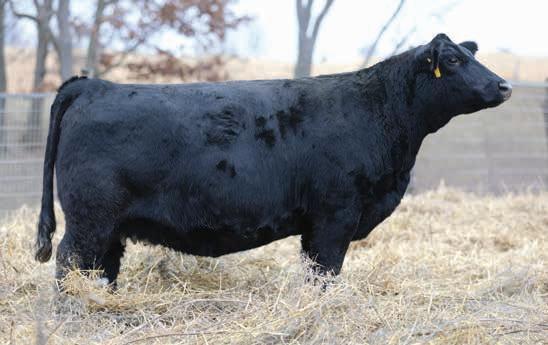
Your favorite non-farm activity to do in your free time?

I love taking photos of livestock, scenery, and sporting events. I also enjoy singing the national anthem at UND volleyball and basketball games!”
Describe your best and worst day.

My most favorite day is when we haul the pairs out to pasture in the spring; second favorite is our production sale day which is the fourth Friday in January.”
What is your least favorite job on the farm?

I am probably pretty unique; I don’t mind picking rocks or painting. I must say, I enjoy every day with the diversity farming and raising livestock offers. The only problem with being busy is finding time to get everything done!”
What is the most used tool on your farm? How old is it?

The most used tool is a Knight Reel Auggie mixer wagon that is used to feed the cattle. It is 24 years old.”


The most important lesson you’ve learned in this business?

Honesty is the best policy; once you develop trust and confidence with your customers life is good.”
more ellingsonsimmentals.com

25TH ANNUAL PRODUCTION SALE: Friday, January 24, 2025 1:00 PM - At the farm near Dahlen, N.D.

















